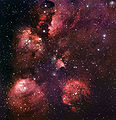astro.wikisort.org - Galaxy
NGC 6334, colloquially known as the Cat's Paw Nebula, Bear Claw Nebula, or Gum 64, is an emission nebula and star-forming region located in the constellation Scorpius.[4] NGC 6334 was discovered by astronomer John Herschel in 1837, who observed it from the Cape of Good Hope in South Africa.[5] The nebula is located in the Carina–Sagittarius Arm of the Milky Way,[6] at a distance of approximately 5.5 kilolight-years from the Sun.[7]

| Emission nebula | |
|---|---|
 Infrared image of the Cat's Paw Nebula. Green areas showing regions where radiation from hot stars collided with large molecules and small dust grains called "polycyclic aromatic hydrocarbons" (PAHs), causing them to fluoresce | |
| Observation data: J2000 epoch | |
| Right ascension | 17 20 50.9h [1] |
| Declination | −36° 06′ 54″[1] |
| Distance | 4.37 ± 0.65 kly (1.34 ± 0.2 kpc)[2] ly |
| Apparent dimensions (V) | 40'×23' |
| Constellation | Scorpius |
| Physical characteristics | |
| Radius | 40 ly |
| Designations | NGC 6334, ESO 392-EN 009,[3] Sharpless 8, RCW 127, Gum 64 |
The nebula is a high mass filamentary cloud structure spanning ~320 ly. In the visible part of the spectrum, it emits mainly in red (from hydrogen atoms) and blue (from oxygen atoms).[8] Several embedded star-forming regions have been identified from infrared and radio emissions. Four of these sites have formed H II regions.[6]
Gallery
- Spitzer view of the star-forming region NGC 6334
- This portrait of NGC 6334 was created from images taken with the Wide Field Imager instrument at the 2.2-metre MPG/ESO telescope at the La Silla Observatory in Chile.
- ESO's VISTA infrared view of NGC 6334
- Submillimetre views of the star formation region
- Protocluster NGC 6334I is a star-forming cloud in the Cat's Paw Nebula.[10]
- The photograph of NGC 6334.
- VISTA infrared view of NGC 6334.
- NGC 6334 photographed in 1986
References
- Kharchenko, N. V.; et al. (2013), "Global survey of star clusters in the Milky Way. II. The catalogue of basic parameters", Astronomy and Astrophysics, 558: 8, arXiv:1308.5822, Bibcode:2013A&A...558A..53K, doi:10.1051/0004-6361/201322302, A53.
- "Trigonometric Parallaxes of High Mass Star Forming Regions: The Structure and Kinematics of the Milky Way". The Astrophysical Journal. 783: 130. 2014. Bibcode:2014ApJ...783..130R. doi:10.1088/0004-637X/783/2/130.
- "NGC 6334". SIMBAD. Centre de données astronomiques de Strasbourg. Retrieved 2007-04-10.
- Nemiroff, R.; Bonnell, J., eds. (2003-07-17). "The Cat's Paw Nebula". Astronomy Picture of the Day. NASA. Retrieved 2007-11-05.
- "NGC 6334 - The Cat's Paw Nebula". SEDS Database. SEDS. Retrieved 2008-04-15.
- Sadaghiani, M.; et al. (March 2020). "Physical properties of the star-forming clusters in NGC 6334. A study of the continuum dust emission with ALMA". Astronomy & Astrophysics. 635: 25. arXiv:1911.06579. Bibcode:2020A&A...635A...2S. doi:10.1051/0004-6361/201935699. A2.
- Russeil, D.; et al. (2012). "Statistical study of OB stars in NGC 6334 and NGC 6357". Astronomy & Astrophysics. 538: A142. Bibcode:2012A&A...538A.142R. doi:10.1051/0004-6361/201117299.
- "NGC 6334, Cat's Paw Nebula(true color)". earthandskyimaging.com. Earth and sky imaging. October 2019.
- "The Cat's Paw and Lobster Nebulae". www.eso.org. Retrieved 6 February 2017.
- "Protostar blazes and reshapes its stellar nursery". www.eso.org. Retrieved 20 March 2017.
External links
- On the Trail of a Cosmic Cat — ESO Photo Release
- NGC 6334 on WikiSky: DSS2, SDSS, GALEX, IRAS, Hydrogen α, X-Ray, Astrophoto, Sky Map, Articles and images
- Astronomy Picture of the Day - Wide Angle: The Cat's Paw Nebula 2010 April 21
- Cat's Paw Nebula at Constellation Guide
На других языках
[de] NGC 6334
NGC 6334, engl. manchmal auch Cat’s Paw Nebula (zu dt. Katzenpfotennebel) oder selten Bear Claw Nebula (zu dt. Bärenklauennebel) genannt, ist ein Emissionsnebel im Sternbild Skorpion. Er ist etwa 5500 Lichtjahre vom Sonnensystem entfernt und hat einen Durchmesser von geschätzten 50 Lichtjahren. Das Objekt ist eines der aktivsten Sternentstehungsgebiete unserer Galaxis und enthält Sterne mit bis zur zehnfachen Sonnenmasse, die in den letzten paar Millionen Jahren entstanden.[3]- [en] NGC 6334
[es] NGC 6334
NGC 6334 (también conocida como Nebulosa Pata de Gato) es una nube de gas radiante o Nebulosa de emisión que parece la gigantesca huella de un gato cósmico recorriendo el Universo. está localizada en la constelación del Escorpión.[1] Fue descubierta por el astrónomo John Herschel en 1837, quien la observó por primera vez desde el observatorio de Cabo de Buena Esperanza en Sudáfrica.[2][ru] NGC 6334
NGC 6334 (другие обозначения — ESO 392-EN9, CED 140, Кошачья лапа[1], Медвежья лапа[2]) — эмиссионная туманность и область звездообразования, которая находится в созвездии Скорпион на расстоянии около 4370 световых лет от Солнца.[3]. Этот объект входит в число перечисленных в оригинальной редакции «Нового общего каталога».Другой контент может иметь иную лицензию. Перед использованием материалов сайта WikiSort.org внимательно изучите правила лицензирования конкретных элементов наполнения сайта.
WikiSort.org - проект по пересортировке и дополнению контента Википедии

![VLT Survey Telescope image shows the Cat's Paw Nebula and the Lobster Nebula.[9]](http://upload.wikimedia.org/wikipedia/commons/thumb/3/34/The_Cat%E2%80%99s_Paw_and_Lobster_Nebulae.jpg/120px-The_Cat%E2%80%99s_Paw_and_Lobster_Nebulae.jpg)



![Protocluster NGC 6334I is a star-forming cloud in the Cat's Paw Nebula.[10]](http://upload.wikimedia.org/wikipedia/commons/thumb/2/23/Protostar_blazes_and_reshapes_its_stellar_nursery.jpg/120px-Protostar_blazes_and_reshapes_its_stellar_nursery.jpg)

